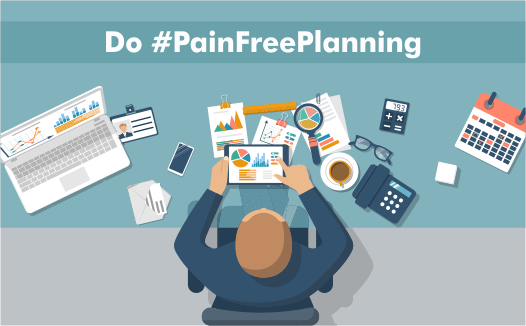Meet Jack : The Account Planner

Meet our muse, Jack. Key Account Manager. Account Planner. Data Interpreter. Relationship Builder. You. You know Jack. He is just like one of us. Surrounded by data, information, statistics, and revenue numbers. Clients who demand the world. Internal stakeholders that need convincing. Jack wears many hats. But that just works. With a family to look after and a life full of interests and hobbies, work-life balance stretches Jack the most. And Jack inspires us to stretch ourselves here at DemandFarm. Here’s why. Let’s talk about Jack in his Account Planner avatar. Jack is accountable for one of the most critical Key Account processes – building the strategy and executing the plan to achieve annual targets. While bridging the gap between planning and execution is a huge challenge, an even bigger pain point is getting started on and building the plan itself. You may identify with Jack’s life around Annual Planning Season. Let’s look at everything that occupies him in the run-up to and during the account planning process. Gathering business insights The most part of Strategic Account Planning involves gathering data from several sources, collating it into a standard format and mining that data for actionable insights to help build the annual plan. A comprehensive white space analysis, competitor analysis and a long hard look at the state of the relationship are other indispensable activities at this stage. This is where he is able to spot the real opportunities for value creation and growth across the length and breadth of his Key Accounts. Collaboration with internal stakeholders Account Planning is one thing and achieving the planned goals is another. It just cannot happen without the engagement of key internal stakeholders, all of whom probably have their own drivers and constraints. An effective annual plan would not only build the business case behind the goals and create buy-in; it also sets targets and expectations from team members. This helps him put everyone on the same page and coordinate the internal effort to achieve the plan. Governing the plan Tracking the plan, measuring performance, quantifying the qualitative indicators effectively – Jack needs to seamlessly bridge the gap between planning and execution. And he needs to check deviations, course-correct and stay flexible enough to grow with the Clients needs and goals. Handling the many aspects of Annual Account Planning can be overwhelming! So here it is. For all the Jacks out there, I get it. Having been a Key Account Manager in my time, I understand how crucial this time of the year is for you. Like I said, we are inspired by the work you do. So we build technology that helps you win. And this Annual Account Planning Season, we want you to try it for yourself. Imagine… An Account Planning technology that: Works from inside Salesforce, using data already in the system Integrates all the data at one place, in one format Creates action plans that you can easily share, leading to specific goals, activities, support required Generates Insights, metrics, and measures for Key Accounts Easily tracks whitespace, people, and actions, seamlessly governs progress And it is yours FREE until the 31st of December 2016. Sign up here and get started on the best Account Planning experience you will ever have. I guarantee it. PS: It’s an all-access pass to our best planning module ever, no questions asked. Sign up today, and unlock the true potential of your Key Accounts.
Annual Planning Pains

It’s that time of year again folks. Yes. Holiday time, Thanksgiving time, Fall time…but also account planning time! Holiday plans, travel plans…and of course, Annual Key Account Plans! You know that adage- if you fail to prepare, prepare to fail! I had that in big bold letters up in my schoolroom back in high school. While it’s 100% true, it doesn’t change the fact that planning time is a big pain. KAM in simpler days and times Before I turned entrepreneur, I was a Key Account Manager with a large automotive giant. And this time of the year, usually meant taking stock of a lot of data from around the company- all on paper in those days- and trying to pore over all the numbers from all the sources and making sense of them, mobilizing my sources to see what the Client was planning for their year to come, strategizing with the leadership to develop my path for the year and of course, bracing myself for the internal sell, in case some major initiatives were needed to remain competitive. The more things change, the more they remain the same. Today, the very definition of key Accounts has gone from large companies to ultra-global matrix organizations, connected digitally across a complex network of relationships, tracking people’s movements across the globe, mountains of data across myriad formats- from PowerPoints to emails to the cloud…everywhere! In real-time…how simple my Key Accounts of yours seem in comparison…with easier lines of command, few verticals, and even fewer geographies. Shaking off the nagging doubt that ‘somethings been missed’… My compatriots in contemporary Strategic Account Management tell me that the sheer complexity of large Accounts today is not the real challenge- the challenge is managing all the data that is generated, and interpreting that to create strategic action points or annual plans. It’s simply not feasible for one individual to manage it manually – even with the help of software and a laptop. It’s amazing how many productive hours are wasted- yes, wasted– in simply collating the data required to start the process of annual planning – so many formats, so many sources. And even then, one can’t be sure if an opportunity to expand or grow has simply been missed or fallen through the gaps because one entity or buying unit or geography or vertical of the Key Account was missed out, or a certain connection wasn’t established with the right person at the right time in the client organization, or a new business vertical was recorded as an independent entity in the CRM system and didn’t show up in the Account data at all… Over to #painfreeplanning So obviously, technology can help track and collate everything better, and overall plan better, and there are lots of tools to make that happen…but the real secret sauce to shift the focus from managing to growing is to spend productive hours on data interpretation and strategic action, not on joining the dots and collating data from various sources, figuring out version control of the many PPTs floating around or cutting and pasting financial data from excel sheets. At DemandFarm, our inspiration is to create #painfreeplanning for KAMs everywhere. Our technology joins the dots and collates all the data in one format, in one place, right inside your CRM. You won’t believe how pain-free it can be till you try it yourself. And, all this month, we are giving you that opportunity. Experience the DemandFarm Salesforce Account Planning module – free for two months; no questions asked – and see if it works for you. More than a thousand Account Managers across verticals have already made the switch…it’s time you experience why. Happy Thanksgiving, Fall, and the upcoming festive season. Most of all, happy #painfreeplanning!
What is wrong with today’s Account Planning?

If I were to answer that in a word – it is ‘Static’ account plans. For too long, Account Plans were long-term in nature (3-5 years) with a fixed set of analyses leading its creation. I think business reality today is far more dynamic and unpredictable to really make long-term account plans. Let me elaborate with examples. Manufacturing companies enjoyed a product life of 8+ years earlier. A car model would last 8 years. So a supplier could work with the manufacturer in the design phase and in turn commit order volumes for several years. Today, products have a maximum life of 24 months. The new manufacturing process and technology favor a smart & nimble supplier. So a manufacturer prefers a tactical vendor who has invested in strategic process & tech. Account Management is a more internal strategy and tactical win with a customer. For over 2 decades, IT services companies enjoyed multi-year-billion-dollar deals. So Account Planning was to ensure the relationship with the CIO & cornering maximum pie in the several billion dollars IT budget. With the SaaS way of IT consumption on the cloud, this model has changed. Almost all department heads are IT buyers but want an expert point solution provider with the ability to connect easily with other software(s). No wonder, small, nimble & smart vendors are winning Martech, Salestech, HRtech, and Fintech deals while larger suppliers are saddled with dying legacy systems management. Our beloved highly skilled Account Managers are expected to make their 2019 account plans with archaic mindset & templates created decades ago. They also know that this is a futile exercise since reality in their account changes in 2 quarters. I believe technology can come to the rescue here. Smart Account Planning tools that can help create plans easily that are simple and dynamic. Also, these Account Planning templates should be able to track these plans and nudge the Account Manager for action. I am in no way saying that strategic account management now is only tactical. Perhaps it is more strategic now. The strategy is in thinking of a better solution for the customer that they haven’t thought about. Earlier the strategy was supplying to customers’ defined strategy. Salesforce account planning is a big bonus favoring you to do all these activities inside the CRM. If you’re interested in transforming your sales post the pandemic, explore our blog on Sales Acceleration in Account Management and how it can help you grow your business in 2021.
Account Planner – Simple is powerful and beautiful too

Key Account Planning over the decades has become complex and theoretical. Most Account Managers just check the box by filling in the template at the beginning of the year and forget about it. In some companies, I have seen the worse. Good Account Managers (who achieve their numbers) just ignore the templates. Account Planning has been around for years. Did you know that 65% of a company’s business comes from existing customers? Or that 80% of your future profits are likely to come from 20% of current customers? In other words, building and cultivating healthy relationships with clients is one of the most effective pathways to exponential growth. With so much at stake, it’s no wonder that 61% of companies consider strategic account management as the key to increasing revenue, profits, and customer satisfaction. While the importance of account management is unquestionable, its implementation leaves a lot to be desired even today. In fact, 71% of companies believe that sales improved by less than 26% since launching their Account Management programs. This observation made us launch ‘Account Planner Pro’ last month while we already have ‘Account Planner Enterprise’ with all the bells and whistles. Account Planner is simple, beautiful, and thus powerful. This is the easiest account planning ever if you use Salesforce or Microsoft Dynamics. This is an one pager app inside your CRM where: Zoom in to your account to build an Account Landscape in 60 seconds. Map opportunities to know where your current engagements with the customer are and therefore where are ‘whitespaces’ of growth. Map competition & relationships. Create a plan with revenue goals and activities. Track the progress I promise you that Account Planning was never this easy. Salesforce Account Planning and MS Dynamics Account Planning are at your fingertips. Go ahead TRY – Ask your CRM admin to install